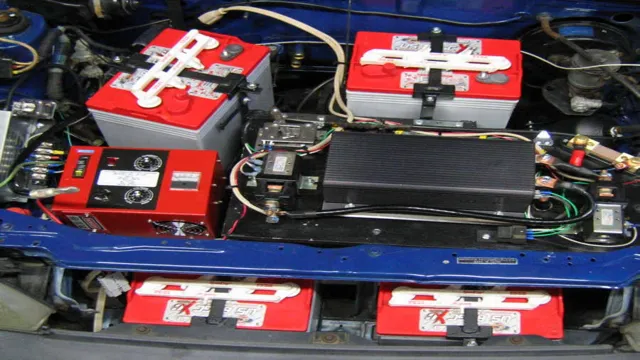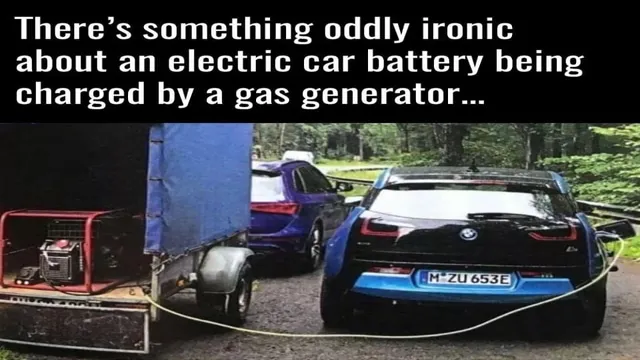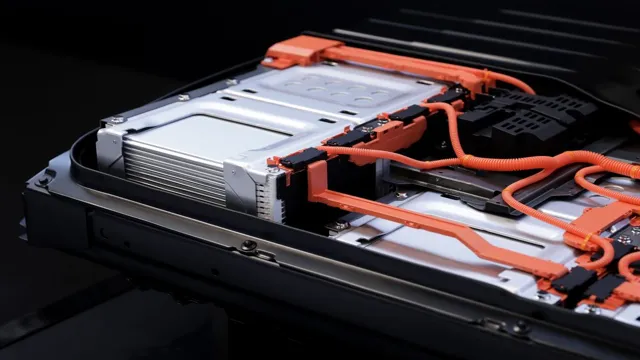Revolutionary Technology: How Electric Cars Utilize Gas Engines to Charge their Batteries
Electric cars have been around for a while now, but many people are still unsure about how they work and what their capabilities are. One question that comes up frequently for those considering an electric car purchase is, “What happens when the batteries run out of charge?” This is where electric cars with a gas engine come in. These vehicles are equipped with both an electric motor and a traditional gas-powered engine, which means that even if the batteries run out of juice, the car can still run on gas.
But what about charging the batteries in the first place? This is another area where these cars differ from their fully electric counterparts. Instead of relying solely on charging stations or home charging setups, electric cars with gas engines have the option to charge their batteries through regenerative braking. Essentially, every time the car brakes, the energy from that process is converted into electricity and stored back in the battery.
So, while electric cars with gas engines still have a gas engine backup, their ability to recharge their batteries in a sustainable way is an additional advantage. It’s important to note that these cars are not the same as traditional hybrid cars, which rely on their gas engines to power the car and only use electric power to assist in certain situations. Rather, electric cars with gas engines rely primarily on their electric motors and batteries, with the gas engine available if needed.
Overall, electric cars with gas engines offer a unique type of hybrid technology that can provide peace of mind to those who may be hesitant about fully committing to an electric vehicle. With the option to recharge the batteries through regenerative braking and backup gas power, these cars provide a versatile and eco-friendly transit option.
How it Works
Have you ever wondered how an electric car can be recharged without plugging it into a charger? Well, it’s all thanks to the gas engine that’s built into the car. Many electric cars on the market today come equipped with a small gas engine that serves as a generator to charge the car’s battery. Essentially, the gas engine works by generating electricity that is then sent to the battery pack, which can be used to power the car’s electric motor.
However, it’s important to note that the gas engine in these cars is not used to directly power the vehicle. Instead, it’s simply used as a way to recharge the battery pack, allowing the car to continue running on electricity for extended periods of time. So the next time you see an electric car on the road, remember that sometimes there’s a small gas engine helping to keep it charged up and running smoothly.
Gas Engine Generates Electricity
A gas engine used to generate electricity works by converting the energy derived from gasoline into electricity through a mechanical process. The operation begins with the combustion of gasoline in the engine, which powers its pistons to move. The movement of the pistons creates a rotational force that drives the engine’s crankshaft.
The crankshaft, in turn, rotates the generator that produces electricity. The generator works by producing an electric current through an electromagnetic field, which is driven by the mechanical energy from the engine’s rotation. The amount of electricity generated depends on the size and power output of the engine and the generator.
The efficiency of gas engines in producing electricity also varies, with newer and more advanced models delivering higher yields. Gas engine-generated electricity is commonly used in remote areas and in backup power systems for facilities like hospitals, data centers, and factories. Its quick start-up times, ability to run for long periods without interruption, and low operating costs make it a reliable source of power.

Electricity Charges Battery
Electricity charges the battery in an electric vehicle. But how does it work? When you plug your EV into a charging station or an outlet at home, the electricity flows from the outlet into the on-board charger. This charger converts the AC (alternating current) electricity from the outlet into DC (direct current) electricity that the battery can store.
Once the electricity is converted, it is sent to the battery, where it is stored for use later. The battery pack is made up of many small individual battery cells that are connected together to form one large battery. Each cell has a positive and negative electrode, and when the battery charges, the lithium ions move from the positive electrode through an electrolyte solution to the negative electrode, storing energy.
When you drive your EV, the process is reversed. The battery discharges, and the stored energy is used to power the electric motor. It’s important to note that the speed at which your EV charges depends on several factors, including the size of the battery, the type of charger you use, and the amount of available electricity.
Benefits of Gas Engine
If you’re considering investing in an electric car, you may be wondering about the benefits of having a gas engine to charge the battery. The truth is that while electric cars are great for the environment, they’re not always practical for long-distance travels. That’s where a gas engine can come in handy.
By using a gas engine to charge the battery, you’re able to extend your range and give yourself peace of mind on long road trips. Plus, with the help of a gas engine, you’ll be able to charge your battery more quickly than with a traditional charging station. So not only is a gas engine convenient, but it’s also fast and efficient.
In fact, many electric car manufacturers have started incorporating gas engines into their designs to make them more versatile and user-friendly. So if you’re looking for a way to improve the functionality of your electric car, adding a gas engine may be the way to go.
Longer Driving Range
As we move towards a greener future, electric vehicles seem to have taken the center stage with their eco-friendly and sustainable reputation. However, the benefits of gas engines cannot be overlooked, especially when it comes to longer driving ranges. Gas engines prove to be extremely efficient when it comes to covering longer distances without the need for frequent recharging, refueling, or battery replacements.
Electric vehicles have yet to achieve a range that matches that of a gas engine, making gas-powered vehicles a popular choice for those who travel long distances frequently. It’s essential to note that gas engines have also seen significant improvements in their fuel efficiency, making them a viable option with reduced environmental impact. Overall, gas engines remain a reliable option for those seeking longer driving ranges without the need for excessive charging or refueling stops.
Less Time Spent Charging
Gas engine cars have numerous benefits, one of which is spending less time charging. Unlike electric cars, gas engine cars can be refueled quickly and easily at any gas station. This means you don’t have to wait for hours to recharge your vehicle, which can be inconvenient if you are in a hurry.
Gas engine cars also have longer driving ranges than electric vehicles, which means you can travel longer distances before needing to refuel. This makes gas engines more practical and convenient for long road trips or vacations where time is of the essence. Additionally, gas engine cars can generate more power and have a faster acceleration than electric vehicles, allowing for a more thrilling and exciting driving experience.
Overall, if you prioritize convenience and speed, a gas engine car may be a better option for you than an electric vehicle.
Flexible Charging Options
Flexible Charging Options One of the many benefits of gas engines for vehicles is the flexibility in charging options. Unlike electric cars that require charging stations, gas-powered cars can be refueled at a variety of locations, including gas stations and convenience stores, as well as being able to carry additional fuel with you on long journeys. It is convenient not to have to worry about the range of your vehicle and anxiety around running out of battery power.
Gas-powered cars can also be refueled quickly, allowing for more time on the road and less waiting at charging stations. The flexibility of gas engines means that you can drive pretty much anywhere you want without the need to search for charging stations or worry about running out of power. While electric cars have their own advantages, gas engines still hold a valuable place in the market for those who value convenience and the ability to travel long distances without any worry.
Drawbacks of Gas Engine
While gas engines have been a reliable source of power for decades, using them to charge the battery of an electric car can present some drawbacks. The first issue is the environmental impact. Gas engines emit greenhouse gases and other pollutants that harm the planet, contributing to climate change and poor air quality.
Another issue is efficiency. When using a gas engine to charge an electric car battery, it limits the vehicle’s range and is less efficient when compared to charging the battery using an electrical outlet. In addition, gas engines require regular maintenance, which can be costly and time-consuming.
Finally, gas engines produce noise, vibration, and odor, which detract from the quiet and smooth driving experience that electric cars provide. When considering these drawbacks, it is clear that using a gas engine to charge an electric car battery is not the most optimal solution. Instead, utilizing an electrical outlet provides a more efficient, environmentally-friendly, and cost-effective option.
Reduced Efficiency
Reduced Efficiency: Drawbacks of Gas Engine One of the major downsides of gas engines is reduced efficiency. Gasoline engines are notorious for their low fuel efficiency compared to electric motors. The inefficiency of gas engines stems from the fact that only a small fraction of the energy produced by burning fuel is actually converted into useful work.
The remaining energy is lost in the form of heat and friction, which makes gas engines less efficient than other types of engines. This inefficiency is also reflected in the cost of fuel. Gasoline prices are usually higher than electricity prices, which makes driving a gas-powered vehicle more expensive than an electric one.
Additionally, gas engines emit more pollutants into the air compared to electric motors, which contribute to air pollution and climate change. Despite these drawbacks, gas engines remain popular due to their ease of use and low initial cost. However, as environmental concerns grow and governments push for more sustainable solutions, it’s likely that gas engines will become less prevalent in the future.
Greater Environmental Impact
One major drawback of gas engines is their greater environmental impact compared to other types of engines. Gas engines rely on fossil fuels, which emit harmful pollutants into the air, contributing to air pollution and climate change. These emissions can also have a negative impact on human health, causing respiratory issues and even cardiovascular problems.
Additionally, the production and transportation of gas also have significant environmental effects, including greenhouse gas emissions and soil and water pollution. As awareness of environmental issues grows, more people are turning to alternative forms of transportation, such as electric or hybrid vehicles, to reduce their impact on the environment. When it comes to the environmental impact of engines, it’s clear that gas engines have plenty of room for improvement.
Conclusion
In conclusion, an electric car with a gas engine to charge its battery is like having a vegan chef prepare a steak dinner – it’s an innovative twist on traditional methods, but it ultimately defeats the purpose. While the gas engine may provide a temporary solution, it undermines the primary goal of reducing emissions and reliance on fossil fuels. It’s time for the automotive industry to fully embrace and invest in purely electric vehicles, rather than relying on half-baked hybrid alternatives.
“
FAQs
How does an electric car use a gas engine to charge its battery?
In some electric cars, there is a gas engine that works as a generator to charge the battery. The engine can turn on automatically when the battery charge drops to a certain level.
Can the gas engine in an electric car charge the battery while driving?
Yes, the gas engine can charge the battery while driving. The engine can act as a range extender for the electric motor.
What is the advantage of having a gas engine in an electric car?
The advantage of having a gas engine in an electric car is that it increases the car’s range and eliminates the need for frequent charging.
Is it more cost-effective to have an electric car with a gas engine than a pure electric car?
It depends on the individual’s driving habits and energy costs. In some cases, having an electric car with a gas engine can be more cost-effective than a pure electric car, but it ultimately depends on the individual’s specific situation.





